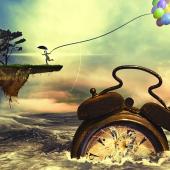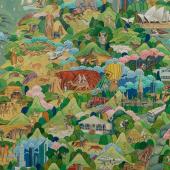Action Painting & Drip Painting
Originated in the European postwar years of World War II, artists, who were originally assigned to surrealism and dadaism, started to bring abstract colours to the canvas by means of pouring, dripping or splashing.
Action Painting is a direct and dynamic painting technique that appears without conscious intervention of the artist. The screen layout does not indicate structures. The colour is roughly painted with a brush on mostly very large canvases, it gets poured, dripped or sprayed. For this reason, for example, the technique of dump imaging is also part of the concept of Action Painting as partly also of Drip Painting.
As the first explicitly named Drip Painting the picture "The confused Planet" by the surrealist and dadaist painter Max Ernst is well-known. At Drip Painting empty cans are used, to which a one to two meter long cord is attached. At the bottom of the can a small hole is made, out of which the colour can flow. In this technique the canvas does not stand on an easel, but lies on the ground. The artist then ongoing swings the box over the canvas. This creates lines that remind on mathematical graphs. While initially the pictures of Max Ernst were relatively unknown, the technique became internationally common through the American painter Jackson Pollock.
The Austrian painter and performance artist Hermann Nitsch, who is assigned to the Viennese Actionism, extended these techniques to dump images. He simply poured colour wild on canvas, whereat streak-like colour effusions occurred.
The Spin Art, or also called Swirl Art, is a colour art that can be referred to as development of Action Painting. Mostly used by children, the toy consists of a turntable on which a white cardboard is mounted. At the outer edges a circular or rectangular outline is attached. The turntable is driven by a motor and the colour is propelled on the paperboard to the outside by the centrifugal force generated. Thus abstract patterns result. Even today, Spin Art devices are often used for paintings.



